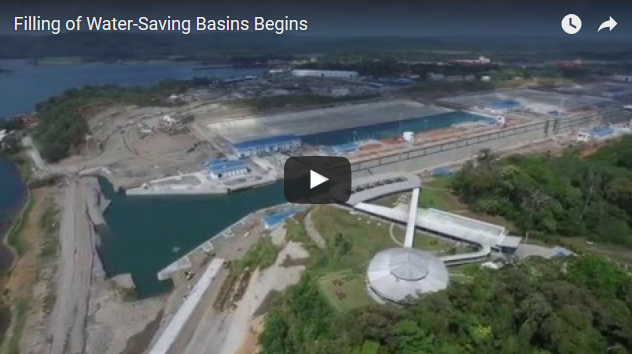The Panama Canal Authority (ACP) has announced that the first water-saving basin of the Agua Clara Locks’ upper chamber has been filled to the required level in order to begin testing the basin’s emptying and filling system to confirm it is watertight.
Contractor Grupo Unidos por el Canal (GUPC) will now proceed with filling the remaining intermediate and lower basins, part of the final phases of the Panama Canal expansion project.
For each of the three chambers in the Agua Clara and Cocoli Locks, there are a total of three water-savings basins, bringing the total to 18 basins for the new locks. Each of the basins is massive, having a surface area equivalent to 25 Olympic-size pools. And each utilizes state-of-the art technology which allows the Canal to reuse 60 percent of the water used per lockage, saving seven percent more than the existing locks do.
“The water used during each lockage comes directly from Gatun Lake, Panama’s main supply of drinking water, so it is absolutely critical we manage this resource responsibly,” said Panama Canal Administrator and CEO, Jorge L. Quijano.
“Managing and protecting the Canal watershed is a top priority for the ACP, which is why we are proactively instituting new and innovative systems such as these water-saving basins to ensure the viability of the Canal for years to come.”
After more than a year-long delay, the new set of larger locks for the Panama Canal will be complete by the end of June, the ACP said on Wednesday, after builders repaired cracks that had formed in the concrete walls.
Panama should start to benefit from the expansion in 2017, when the government foresees getting an extra $1.4 billion in revenue, a jump of 30 percent compared with this fiscal year.
According to a Reuters report, the project was initially set to be finished at the end of 2014, but the date was pushed back to April of this year due to a dispute between the administrator and the building consortium over costs.
The Reuters report also claims that the plan was originally set at $5.25 billion, but the builders successfully argued for an extra $3.2 billion, of which the government has paid $250 million so far.
However, a spokesperson for ACP has stated: “The statement that the delay of the expansion opening was caused by a dispute over costs is not accurate. The ACP has never delayed payment to GUPC. In fact, the ACP typically pays the contractor GUPC before it is contractually obligated—typically 30 days, far sooner than the 56 allowed.”
She continued: “The government of Panama has never paid for GUPC’s claims, as they are not contractually obligated to do so. Therefore, anything stating otherwise is inaccurate.”
